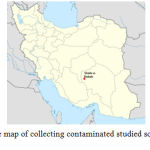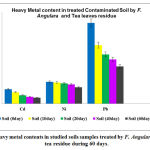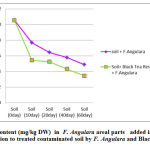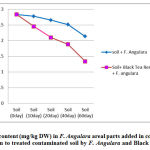Manuscript accepted on :February 24, 2016
Published online on: 21-03-2016
Plagiarism Check: Yes
Zahra Jallilian1 and Parisa Ziarati 2,3*
1Pharmacy Faculty, Pharmaceutical Sciences Branch, Islamic Azad University (IAUPS), Tehran –Iran. 2Young Researchers and elite Club, Pharmaceutical Sciences Branch, Islamic Azad University, (IAUPS), Tehran, Iran. 3Department of Medicinal chemistry, Pharmaceutical Sciences Branch, Islamic Azad University (IAUPS), Tehran –Iran. Corresponding Author Email: ziarati.p@iaups.ac.ir
DOI : https://dx.doi.org/10.13005/bpj/927
Abstract
The efficacy of various plants in eliminating different heavy metal contaminants, particularly Lead and Cadmium is a major concern nowadays due to the vast soil pollution in many countries around the world especially Iran. In this research determination of the potential ability of dried aerial parts of Ferulago Angulara in companion of black tea residue for cleaning up contaminated soil and their probable capability of adsorption different heavy metals (Nickel, Lead and Cadmium) was investigated. F. Angulara were collected in August 2015 from Kermanshah Province, Iran and samples was identified by the Herbarium of Faculty of Pharmacy, Pharmaceutical Sciences Branch, Islamic Azad University (IAUPS).The contaminated soil by Ni, Cd and Pb was put into the sites in a way that F. Angulara and tea leaves residue were mixed in different percentages up to 20%-20% (W/W) in examined soils individually and both of plants together in order to find the effect of companion residues in possible potential biosorption . Metal contents were detected by Atomic Absorption Spectrophotometer by wet digestion method in every 10 days during 60 days in Research Laboratory. Results indicated that the rate of heavy metals uptake by F. Angulara is significantly affected by the presence of dried tea leaves residues (p<0.003 ) . Tea leaves are more capable in absorbing nickel than F. Angulara and when we put both together in 20%-10% (tea leaves/ F. Angulara) the potential of taking up nickel significantly enhanced (p<0.01 ) .The Cadmium and Lead uptake rates by F. Angulara areal parts are significantly affected by pH and companion in the contaminated soil (p<0.001). The results of this research concluded that F. Angulara and tea residue in the contaminated soil have suitable ability for adsorption method and removing more Lead and Nickel in pH <7 after 20-60 days of study.
Keywords
Biosorption; Ferulago Angulara ; Tea leaves residue; Heavy metals
Download this article as:| Copy the following to cite this article: Jallilian Z, Ziarati P. High Potential of Ferulago angulate (Schlecht) Boiss. in Adsorption of Heavy Metals. Biomed Pharmacol J 2016;9(1) |
| Copy the following to cite this URL: Jallilian Z, Ziarati P. High Potential of Ferulago angulate (Schlecht) Boiss. in Adsorption of Heavy Metals. Biomed Pharmacol J 2016;9(1). Available from: http://biomedpharmajournal.org/?p=6620 |
Introduction
The capacity of sediments to accumulate compounds makes them one of the most important tools to assess contamination of inland aquatic ecosystems [1]. Sediment quality assessments are often conducted to identify highly polluted areas that may require management action in order to protect or restore aquatic habitats [2]. One of the major concerns of healthy soils in the environment is heavy metals which can be accumulated in vegetables and crops grown on due to the probability of food contamination through the soil-root interface. Although heavy metals such as Nickel, Chrome, Lead, cadmium and etc are not necessary for plant growth, however they are passionately taken up and accumulated by plants up to toxic levels [3-7]. In public attitude, phytoremediation technology is more favorable due to its potential for cleaning up environment and the overall aesthetic perfection of the contaminated sites [8, 9]. Metallophytes are endemic plant species of natural mineralized soils and, therefore, have developed physiological mechanisms of resistance and tolerance to survive on substrates with high metal levels [10-12]. Since metallophytes, in general, and hyperaccumulators, in particular, are relatively rare and usually produce reduced biomass, the study of pseudometallophytes and indigenous species of contaminated soils, is of great value. Pseudometallophyte species (or facultative metallophytes) aren’t specialized in metalliferous soils and have a more extensive distribution, but, due to selective pressure, are capable to survive in metalliferous soils [13-19]. Plants are ideal agents for soil and water remediation because of their unique genetic, biochemical and physiological features [20-24] . Phytoremediation requires prudent selection of resistant, preferably native plants with the greatest possible germination, growth, expansion, and root surface area [25]. Some studies have suggested the efficacy of various plants in eliminating different heavy metal contaminants, particularly Lead and Cadmium. A few studies proved that some plants in accompany with each other can boost the potential of transition factor of heavy metals [23, 26].
Ferulago is a genus belonging to the Apiaceae family [27]. It has 35 species, of which seven grow wild in Iran. Ferulago angulata is one of these species that are found in their natural state in Iran [28], basically belongs to west of Iran. Traditionally this plant was added to different products to prevent from decay as well as give them a pleasant taste. Different concentration of essential oil and extract were added to vegetable oil. Peroxide and Thiobarbituric indexes of samples were determined and compared with blanks samples (without any antioxidant and with TBHQ) showed that minimum concentration of extract for conserving of vegetable oil is about% 0.02 under excremental conditions. Extract with 0.5% concentration is more effective than TBHQ[29].
Ferulago species are used in folk medicine for their sedative, tonic, digestive and anti-parasitic effects [27-29]. Antibacterial and antifungal activities have previously been investigated for some Ferulago as a food preservative [28]. F. angulata (referred to locally as Chavir) is a perennial shrub with the height 60-150cm [31] that grows 1900-3200m (above sea level) [32-33] The F. angulata have two subspecies; subsp. angulata (Schlecht) that is wide spread in Turkey, Iraq and Iran, and subsp. carduchorum which is endemic to the Shahoo Mountains of west Iran [32].
Material and Methods:
Study Area of Plant Sampling
The aerial parts of F. angulata subsp. carduchorum were collected respectively from of Shahoo Mountains, Kermanshah province west of Iran. The voucher specimen is deposited in the herbarium of pharmaceutical Sciences Branch, Islamic Azad University, Tehran, Iran. The aerial parts were cut into pieces and air-dried for even days at room temperature (17-25°C).
Study Area of Soil Sampling
The Shahre-e-Babak covers an area of 13572 km2 in the north-western part of Kerman Province, south part of Iran. The Shahre-e-Babak is located between approximately N54º23′ to 55º48′ and E29º49′ to 31º10′. There are major anthropogenic sources of metals such as Maiduk Copper Complex and Khatoon-Abad Copper Smelter in the central and south-eastern part of the study area, respectively [33]. They enter toxic metals from mining activities to their adjacent environment which has adverse effect on soil, plants, animals, and public health. It should be mentioned that, agricultural activities and animal breading are the main job of the people in the study area. These anthropogenic sources of metals not only affect public health, but also have adverse effect on economic state of the residents due to interference with their activities. Although the Shahr-e-Baback receives considerable amount of toxic metals, there are not any deep studies about metal pollution state in the study area. Contaminated soil samples were collected from around copper smelter . Fifty soil samples (0-5 cm) were collected on August 2015 from surface of Shahr-e-Babak soil (Fig.1). Most of samples were collected adjacent to Khatoon-Abad Copper Smelter and Maiduk Copper Complexes. Also, some samples were collected from unpolluted sites (far from the major anthropogenic sources) to determine metals background. Collected samples were transferred to the laboratory in plastic bags.
 |
Figure 1- The map of collecting contaminated studied soils sampling . |
At the beginning of study, soil profile characteristics were observed and recorded by a packet penetrometer (Cl-700A, soil Test Inc., USA). Soil samples were mixed, homogenized and separated into three parts, 1/3 of each samples was air-dried and pass through a 2 mm sieve in order to determine p and k content, pH and electrical conductivity and particle-size distribution. The other 2/3 was passed through a 2 mm sieve without drying and 1/3 of it used to determine heavy metals concentration by Atomic Absorption Spectroscopy (AAS) after digestion with aqua-regia. The samples were analyzed by an Atomic Absorption Spectrophotometer Model AA-6200 (Shimadzu, Japan) using an air-acetylene flame for heavy metals: Pb, Cd and Ni using at least five standard solutions for each metal. All necessary precautions were taken to avoid any possible contamination of the sample as per the AOAC guidelines [13].
Sampling method
Dried aerial parts of Ferulago Angulara in companion of black tea residue were separated and washed and digested by wet method according the standard protocol for measuring Cadmium , nickel and Lead. Mean values were calculated, and analysis of variance (ANOVA) and Student’s t-test were performed. Bioaccumulation factors (BAF-s) were calculated for heavy metal content of plant parts (mg/kg) / heavy metal content of soil (mg/kg), for each metal.
The last port used to determine nitrate and ammonium 2M KCl extraction followed by determination using flow injection method. All the soil data are expressed on a dry basis. The soil by different pH put into 50 vases and coriander were grown in 48 examined soils and no plants were grown in two others as they have been considered as control group in soils, as the same procedure in the other reports of scientists who have investigated the effects of soil acidification on Zn and Cd phytoextraction [14] . As soil acidification might cause some negative side effects such as increasing solubility of some toxic metals and leaching them into the groundwater and creating another environmental risk. Therefore, at the beginning of study, we tried to control pH at the range of 5.9 up to 6.9 in samples of soils.
All samples were watered each day by tap water (Tehran tap water). The studied samples were managed by the same light situation and some circumstances in order to be compared with each other due to determine the ability of F. angulata in adsorbing Lead, Cadmium and Nickel from soil and its potential to avoid transferring heavy metals to coriander and keep safe the eating vegetable .
Physical and chemical properties and concentrations of heavy metals (Cadmium, Nickel and Lead,) in soils, before and after adding F. Angulara in companion of tea residue in the growth period of cultivated coriander were measured in every ten days. In order to assess amount of heavy metals in the soil samples, heavy metal concentrations in soils of studied vases were determined by atomic absorption spectrophotometer [15, 34-38].
Samples were then digested with HNO3/HCL/H2O2 according to U.S.EPA 3050B test method to determination of total metals (Pb, Ni and Cd) concentrations (U.S.EPA, 1986).
Electrical conductivity:
Soil suspension prepared with soil and deionized water in 1:5 ratios (10 grams of soil and 50 mL of water) was allowed to stand for one hour. Soil electrical conductivity was analyzed using a potable combo probe (Hanna Instruments).
Statistical Analysis
Mean values were calculated, and one way ANOVA using the Minitab 15.0 statistical software was used for the analysis of data in all studies . Potential of adsorbing areal parts of F. Angulara in the presence of tea leaves residue and without them were calculated for heavy metal contents of studied soils (mg/kg) for each metal.
Results and Discussion
Chemical extraction of the soil profile before adding specified amounts of F. Angulara is shown in the table 1 and electrical conductivity and nitrate content in different layers is indicated in table 2. Data is averages of the profiles.
Table 1: Physical and Chemical properties of the studied soil samples before planting
| Characteristic | Quantity | Characteristic | Quantity |
| Soil Texture | Silty Clay Loam | Sand (%) | 14.3 |
| Clay (%) | 38.7 | Silt (%) | 47.0 |
| Ni (mg/kg DW) | 7.4356 | Cd (mg/kg DW) | 2.2304 |
| Pb (mg/kg DW) | 10.2331 | Cu (mg/kg DW) | 25.4609 |
Table 2: The characteristics of soil samples of Mining Area, Shahr-E-Babak, Iran, before treating by F. Angulara
| Layer
(depth cm) |
pH (H2O) | Electrical conductivity
dS/cm 1:1 |
NO3-N
mg/kg DW |
NH4-N
mg/kg DW |
| 1 (0-20) | 6.5 | 0.58 | 65.2 | 10.66 |
| 2 (20-40) | 6.8 | 0.41 | 30.9 | 10.43 |
Results showed F. Angulara adsorption for all heavy metals in treated soil were affected significantly by adding black tea residue and F. Angulara not only affected contaminated soil and can up-take lead, Cadmium and Nickel after 10 days (p<0.01) more than other studied times but also adding black tea residue have synergic effect in taking up heavy metals especially in adsorbing lead more than two other studied heavy metals. . In figure 2 the treating contaminated soil trend by this plant indicates that dried F. Angulara areal parts in the soil which is enriched by balck tea leaves can be consider as a suitable method for rescuing soil by its relatively large ratio of biomass concentration of the contaminant to soil concentration.
 |
Figure 2: Heavy metal contents in studied soils samples treated by F. Angulara and black tea residue during 60 days. |
The rate of uptaking cadmium by areal parts of F. Angulara in treated soil was obviously high especially after 20 days ( figure 3 ). The amount of Cd deposited in soils treated by both treated dried plants differed significantly (p<0.02). As expected the Cd uptake rate by F. Angulara is significantly affected by time duration and by mixing by tea residue (p<0.01) while for lead (figure 4) the p-value was less than 0.03after 10 days being treated.
 |
Figure 3: Cadmium content (mg/kg DW) in F. Angulara areal parts added in contaminated soil in comparion to treated contaminated soil by F. Angulara and Black tea residue. |
 |
Figure 4: Lead content (mg/kg DW) in F. Angulara areal parts added in contaminated soil in comparion to treated contaminated soil by F. Angulara and Black tea residue |
Even though the Nickel concentration in Ni treated soils in 40 and 60 days treated by F. Angulara and Black tea residue is higher compared to other studied times ( figure 5).
 |
Figure 5- Nickel content (mg/kg DW) in F. Angulara areal parts added in contaminated soil in comparion to treated contaminated soil by F. Angulara and Black tea residue |
The results of this research concluded that F. Angulara in the contaminated soil had suitable ability for adsorption heavy metals and indicated that the rate of heavy metals uptake by F. Angulara is significantly affected by the presence of dried plant (p<0.003 ) . Tea leaves are more capable in absorbing nickel than F. Angulara and when we put both together in 20%-10% (tea leaves/ F. Angulara) the potential of taking up nickel significantly enhanced (p<0.01 ) .The Cadmium and Lead uptake rates by F. Angulara areal parts are significantly affected by pH and companion in the contaminated soil (p<0.001). The results of this research concluded that F. Angulara and tea residue in the contaminated soil have suitable ability for phytoremediation by phytoextraction method and transmitting more Lead and Nickel in pH <7 after 20-60 days of growth of plants. The synergic effect of mixing dried areal parts of F.Angulara by black tea residue , is referred to as the environmental friendly method for recuing contaminated soils, therefore our results showed that even the residue parts of some plants probably tolerate and adsorb more metal toxicity and are active in treating contaminated soil. Mechanisms for adsorbing toxic metals should be examined in a risk-based approach in order to determine impacts of metal speciation for other companion dried and residue plants. Regarding the results of the present study, it is recommended to study more on the species belong to other companion plant families that have potential ability to biosorbing heavy metals more effectively.
Acknowledgment
Pharmaceutical Sciences Branch, Islamic Azad University (IAUPS) is gratefully acknowledged.
References
- Agah, H., Hashtroodi, M., Baeyens, W. Trace Metals Analysis in the Sediments of the Southern Caspian Sea. Journal of the Persian Gulf . 2011;2(6): 1-12.
- Hunt, J. W., Anderson, B. S., Phillips, B. M., Newman, J., Tjeerdema, R. S., Fairey, R., Puckett, H. M., Stephenson, M., Smith, R. W., Wilson, C. J. , Taberski. K. M. Evaluation and use of sediment toxicity reference sites for statistical comparisons in regional assessments. Environmental Toxicology and Chemistry .2001; 20: 1266– 75.
- Mussarat, M. Bhatti, A.U. Heavy metal contents in fodder crops growing in the vicinity of Peshawar city. Soil Environ. 2005; 24: 58-62.
- Yang, T.X., M.S. Li, Y. Li, Huang, R. Study on heavy metal pollution in soil and plants in Pingle Manganese Mine, Guangxi and implications for ecological restoration. Mining Saf. Environ. Protec,2006; 1: 21-3.
- Akguc, N., Ozyigit, I.I. , Yarci, Pyracantha coccinea roem. (Rosaceae) as a biomonitor for Cd, Pb and Zn in mugla province (Turkey). Pak. J. Bot, 2008; 40: 1767-76.
- Mukhtar, , Haq Nawaz Bhatti , M. K., Anwar Ul Haq , M. , Sher M. S.H. Potential of Sunflower (HELIANTHUS ANNUUS L.) for Phytoremediation of Nickel (Ni) and Lead (Pb) Contaminated Water . Pak. J. Bot., 2010; 42(6): 4017- 26.
- Chen, H. Cutright, J. The interactive effects of chelator, fertilizer, and rhizobacteria for enhancing phytoremediation of heavy metal contaminated soil. J. Soils Sedi. 2002; 2: 203-10.
- Fayiga, A.O., L.Q. Ma, X. Cao , Rathinasabapathi, B. Effects of heavy metals on growth and arsenic accumulation in the arsenic hyperaccumulator Pteris vittata L. Poll., 2004; 2: 289-96.
- Baker , A.J.M. Accumulators and excluders – strategies in the response of plants to heavy metals. of Plant Nutrition, 1981; 3: 643-54.
- Baker, J.M., Walker, P.L. Ecophysiology of metal uptake by tolerant plants. In Shaw AJ. (ed.) Heavy metal tolerance in plants: Evolutionary aspects. Boca Raton, Florida: CRC Press, Inc.; 1990; 155-193.
- Paulo, J.C., Favas, João P., Mayank V., Rohan, D’S. , Manoj, P. Phytoremediation of Soils Contaminated with Metals and Metalloids at Mining Areas: Potential of Native Flora. Chapter 17. Environmental Risk Assessment of Soil Contamination. Pp 492-493. Available in Site: http://cdn.intechopen.com/pdfs-wm/46355.pdf .
- Becerril, M., Barrutia, J.L., Garcia Plazaola, A., Hernández, A., Olano , J.M., Garbisu, C. Es‐pecies nativas de suelos contaminados por metales: aspectos ecofisiológicos y su uso en fitorremediación. Ecosistemas, 2007; 16(2): 50-5.
- Quintela-Sabarís , C., Ribeiro, M.M., Poncet, B., Costa, R., Castro-Fernández , D., Fraga M.I. AFLP analysis of the pseudometallophyte Cistus ladanifer: comparison with cpSSRs and exploratory genome scan to investigate loci associated to soil variables. Plant and Soil , 2012; 359 : 397-413.
- Becerra-Castro, C., Monterroso, C., Prieto-Fernández, A., Rodríguez-Lamas, L., LoureiroViñas, M., Acea, M.J., Kidd, P.S. Pseudometallophytes colonising Pb/Zn mine tailings: A description of the plant–microorganism-rhizosphere soil system and isolation of metal-tolerant bacteria. Journal of Hazardous Materials. 2012; 217(218 ) : 350-59.
- Becerril, J.M., Barrutia, J.L., Garcia Plazaola, A., Hernández, A., Olano, J.M., Garbisu, C. Especies nativas de suelos contaminados por metales: aspectos ecofisiológicos y su uso en fitorremediación. Ecosistemas, 2007; 16(2) : 50-5.
- Becerra-Castro, C., Monterroso, C., Prieto-Fernández, A., Rodríguez-Lamas, , LoureiroViñas, M., Acea, M.J., Kidd, P.S. Pseudometallophytes colonising Pb/Zn mine tailings: A description of the plant–microorganism-rhizosphere soil system and isolation of metal-tolerant bacteria. Journal of Hazardous Materials.2012; 217(218 ) : 350-59.
- Quintela-Sabarís, C., Ribeiro, M.M., Poncet, B., Costa, R., Castro-Fernández, D., Fraga, M.I. AFLP analysis of the pseudometallophyte Cistus ladanifer: comparison with cpSSRs and exploratory genome scan to investigate loci associated to soil variables. Plant and Soil .2012; 359: 397-413.
- Paulo, J.C., Favas, J. ., Mayank, V., Rohan, D.S., Manoj, S. P. Phytoremediation of Soils Contaminated with Metals and Metalloids at Mining Areas: Potential of Native Flora. Chapter 17, page 492. Available in site: http://cdn.intechopen.com/pdfs-wm/46355.pdf.
- Manshadi, M ., Ziarati, P., Ahmadi, M., Fekri, K. Greenhouse Study of Cadmium and Lead phytoextraction by five Pelargonium spices. IJPAES, 2013; 2(18) : 665-9. Available online at ijfas.com.
- Ahmadi,M., Ziarati, P., Manshadi, M., Asgarpanah, J., Mousavi, Z. The Phytoremidiation Technique for Cleaning Up Contaminated Soil by Geranium (pelargonium roseum). IJPAES , 2013;2(15) : 477-481. Available online at ijfas.com.
- Ziarati, P., Alaedini, S. . The Phytoremediation Technique for Cleaning up Contaminated Soil By sp. J Environ Anal Toxicol ,2014; 4: 208. doi: 10.4172/2161-0525.1000208.
- Ziarati, P., Iranzad-Asl, S., Asgarpanah, J. . COMPANION PELARGONIUM ROSEUM AND ROSMARINUS OFFICINALIS IN CLEANING UP CONTAMINATED SOIL BY PHYTOEXTRACTION TECHNIQUE THE ROLE OF COMPANION PLANTS IN BOOSTING PHYTOREMEDIATION POTENTIAL. IJPAES . 2014 ; 4(3): 424-430.
- Ziarati, P., Zolfaghari, M., Azadi, B . THE EFFECT OF TEA RESIDUE IN PROMOTING PHYTOREMEDIATION OF LAVANDULA ANGUSTIFOLI MILL. IJPAES . 2014; 4 (2) : 479-486.
- Adam, G. , Duncan, H. Influence of Diesel Fuel on Seed Germination. Environmental Pollution, 2002; 120: 363-370 .
- Ziarati , P., Hosseini, A. THE EFFECT OF FENNEL (FOENICULUM VULGARE) ON POTENTIALPHYTOREMEDIATION OF PELARGONIUM. . IJPAES , .2014; 4(2) : 438-445.
- Rechinger, K.H., Hedge, I.C., Lamond, J.M. Flora Iranica. Graz: Akademische Druckund Verlagsanstalt, 1987; 428-30.
- Khanahmadi, M., Rezazadeh, S.H. Study on Chemical Composition of Essential oil and Anti-oxidant and Anti Microbial Properties of Artemisia haussknechtii. Medicinal Plants. 2009; 8 (31): 132 – 41.
- Baser, H.C. , Demirci, B., Demirci, F. A new monoterpene ester from Ferulago thirkeana essential oil. Planta Med. 2002; 68: 564-7.
- Ozturk, B., Gur, , Coskun, M. Relaxant effect of Ferulago syriaca root extract on human corpus cavernosum. Eur Urol Suppl. 2004; 3: 62.
- Taran, M., Ghasempour, R., Shirinpour, E. Antimicrobial activity of essential oils of Ferulago angulata subsp. Carduchorum. Jundishapur Journal of Microbiology . 2010; 3(1): 10-14.
- Rustaiyan, A., Sedaghat, S., Larijani, K., Khossravi, M. & Masoudi, S. Composition of the essential oil of Ferulago angilata (schlecht.) Boiss. Journal of essential oil research, 2002;14(6): 447-448.
- Rechinger KH, Hedge IC, Lamond JM. Flora Iranica. Graz: Akademische Druckund Verlagsanstalt; 1987: 428-30.
- Damangir, A. A., Baghvand, A., Monavari, S. M., Moattar, F. Metal Pollution Assessment in Soil Samples of Mining Area, Shahr-E-Babak, Iran. International Journal of Advanced Biological and Biomedical Research. 2015; 3 (1):24-34.
- ziarati, P., Nazif, M. H., Khandehrouy, M. . Decreasing Bio-toxicity of Fume Particles Produced in Welding Process by Aloe vera L. Oriental Journal of Chemistry. 2015; 31(4),
- Ziarati,P., Ziarati,N.N., SYNERGIC PHYTOREMEDIATION POTENTIAL OF HEAVY METALS BY SORGHUM BICOLOR L. IN COMPANION OF SUNFLOWER (HELIANTHUS ANNUUS L.). International Journal of Pharmacy Practice and Pharmaceutical Sciences.2015, 2(4).
- Ziarati, P., Asgarpanah , J ., MirMohammad Makki, Phytoremediation of Heavy Metal Contaminated Water Using Potential Caspian Sea Wetland Plant: Nymphaeaceae. BIOSCIENCES BIOTECHNOLOGY RESEARCH ASIA, 2015; 12(3): 2467-2473.
- Ziarati, P., Alimardan, M. Study on Increasing Efficiency of Phytoremediation in Cadmium and Nickel Contaminated Soil. Chemistry Journal .2015; 5(6): 86-92.







